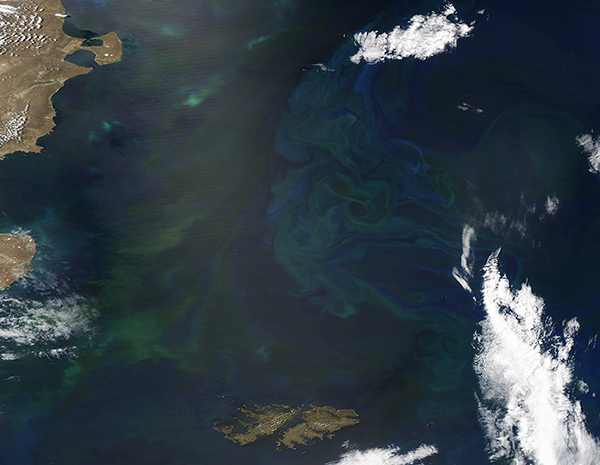Images
November 18, 2022 - Bloom in the South Atlantic
Tweet
Gorgeous jewel-toned greens and blues swirled in a vast expanse of the South Atlantic Ocean in mid-November 2022. The colors stretch from north of Argentina’s Valdez Peninsula southward to the Falkland Islands and from just offshore to more than 400 miles across the open sea. The Moderate Resolution Imaging Spectroradiometer (MODIS) on board NASA’s Aqua satellite acquired a true-color image of the spectacular scene on November 16.
The colors are created by blooms of phytoplankton, which are microscopic plant-like organisms that live in these waters year-round in small numbers. Spurred by abundant nutrients, proper temperatures, and lengthening daylight, phytoplankton can reproduce explosively to create large floating masses that can easily be seen from space. The variety of colors suggest that these waters contain several species of phytoplankton, each containing a different set of pigments, which lend their tones to the bloom.
Large blooms frequently color the South Atlantic Ocean in this location, especially in the spring and summer, when sunlight is abundant and sea surface temperatures warm. This spot is also a convergence zone, where two strong ocean currents collide. The icy Malvinas Current, which is an offshoot of the frigid Circumpolar Current that circles Antarctica, shoots northward along the coast of South America. At the same time, the Brazil Current carries warm sub-tropical waters southward. In addition, warm water pours into the Atlantic Ocean from the Rio de la Plata between Argentina and Uruguay, and is carried southward. These currents mix and mingle in the South Atlantic north of the Falkland Islands, creating a rich and diverse haven for marine life—including phytoplankton.
Image Facts
Satellite:
Aqua
Date Acquired: 11/16/2022
Resolutions:
1km (1 MB), 500m (2.7 MB), 250m (6.1 MB)
Bands Used: 1,4,3
Image Credit:
MODIS Land Rapid Response Team, NASA GSFC
Tweet
Gorgeous jewel-toned greens and blues swirled in a vast expanse of the South Atlantic Ocean in mid-November 2022. The colors stretch from north of Argentina’s Valdez Peninsula southward to the Falkland Islands and from just offshore to more than 400 miles across the open sea. The Moderate Resolution Imaging Spectroradiometer (MODIS) on board NASA’s Aqua satellite acquired a true-color image of the spectacular scene on November 16.
The colors are created by blooms of phytoplankton, which are microscopic plant-like organisms that live in these waters year-round in small numbers. Spurred by abundant nutrients, proper temperatures, and lengthening daylight, phytoplankton can reproduce explosively to create large floating masses that can easily be seen from space. The variety of colors suggest that these waters contain several species of phytoplankton, each containing a different set of pigments, which lend their tones to the bloom.
Large blooms frequently color the South Atlantic Ocean in this location, especially in the spring and summer, when sunlight is abundant and sea surface temperatures warm. This spot is also a convergence zone, where two strong ocean currents collide. The icy Malvinas Current, which is an offshoot of the frigid Circumpolar Current that circles Antarctica, shoots northward along the coast of South America. At the same time, the Brazil Current carries warm sub-tropical waters southward. In addition, warm water pours into the Atlantic Ocean from the Rio de la Plata between Argentina and Uruguay, and is carried southward. These currents mix and mingle in the South Atlantic north of the Falkland Islands, creating a rich and diverse haven for marine life—including phytoplankton.
Image Facts
Satellite:
Aqua
Date Acquired: 11/16/2022
Resolutions:
1km (1 MB), 500m (2.7 MB), 250m (6.1 MB)
Bands Used: 1,4,3
Image Credit:
MODIS Land Rapid Response Team, NASA GSFC




